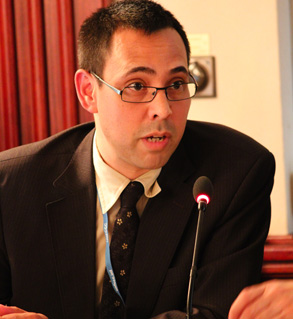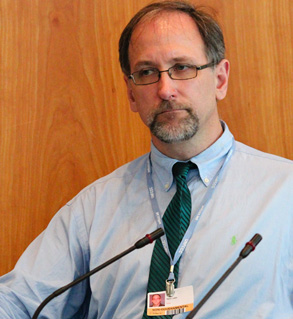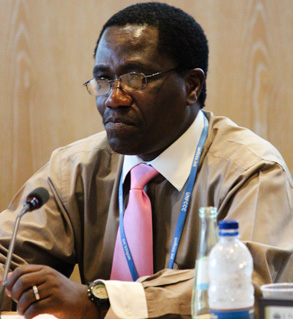|
|
 |
 |
 |
 |
 |
| Andrew Howard, UNFCCC Secretariat, reminded those present that the recommendations for new JI Guidelines have no status until the COP/MOP adopts them. |
|
 |
 |
 |
 |
|
|
|
The event provided an opportunity for the Joint Implementation Supervisory Committee (JISC) members to provide an update on their work and respond to questions from stakeholders. JISC Chair Wolfgang Siedel, Germany, updated the audience on the status of Joint Implementation (JI) projects, noting increases in the number of emission reduction units (ERUs) starting in 2011 and continuing this year. Siedel outlined three areas for the JISC’s management action plan: greater efficiency and operation; enhanced promotion; and effective contribution to the future development of the JI.
On the last item, Siedel introduced a concept note representing a “fundamental rethink of how the JI mechanism can work.” He stressed the concept note is a draft for discussion with JISC members, stakeholders and the UNFCCC Conference of the Parties serving as the Meeting of the Parties of the Kyoto Protocol (CMP). He explained that CMP 7 assured the JI’s future and asked the JISC to prepare recommendations for a new set of JI guidelines for CMP 8. Siedel underscored the need for clear roles between host countries and an international oversight body. The international oversight mechanism, which he called “the new JISC,” would oversee key procedural tasks and ensure high standards for all new activities. Siedel noted the possibility of greater alignment with the Clean Development Mechanism and other accreditation bodies.
Stakeholders asked several questions related to the new JISC on governance, transitional issues, links to the new market mechanism and additionality. On governance, Siedel stated that if new JI guidelines are not approved, the current guidelines apply. A stakeholder asked if current projects would be subject to new guidelines or eligible for additional ERUs. In response, Siedel, and JISC member Piotr Dombrowicki, Poland, acknowledged transitional issues are important, requiring discussion and elaboration. Siedel responded that the JISC could assume responsibilities under the new market mechanism, but these details are far from decided. On additionality, Siedel responded it is important to expect and consider differing views. |
 |
 |
 |
 |
 |
| Mark Lutes, WWF, suggested that the shipping sector could be a testing ground for ideas that will set a precedence for the evolution for the broader climate deal. |
|
 |
 |
 |
 |
|
|
|
Moderator Tasneem Essop, WWF, contextualized the presentations on scaling-up finance to achieve 2020 objectives with a call to respond to the urgency to increase financial ambition.
Jochen Harnisch, KfW Development Bank, warned that reducing investment risk to leverage private finance is not a silver bullet. He concluded that a focus on energy access in least developed countries, dedicated cost effective mitigation policies in emerging Organization for Economic Co-operation and Development (OECD) economies, and improved and maintained investments, is necessary.
Richard Sherman, Department of Environmental Affairs, South Africa, discussed what can be achieved in Qatar, noting the incoming Qatar presidency is likely to place emphasis on a strong outcome on long-term finance at COP 18. He said the long-term finance workshop process needs to: focus on lessons learned from fast-start finance; clear assessment of developing country needs; and start work on options for mobilizing US$ 100 billion.
Maria Athena Ronquillo-Balesteros, World Resources Institute (WRI), noted a lack of research on this issue, highlighting three areas of ongoing research: analysis of the World Bank Group on lessons learned; case studies from developing countries; and pre-investment. She noted preliminary findings: targeted funds addressing investment risk can leverage capital; the risk-reward balance can be improved by reducing political and low-carbon market risk; and the most commonly used technique is loans, provided directly to governments.
Norbert Gorißen, Federal Ministry for the Environment, Nature Conservation and Nuclear Safety (BMU), Germany, shared new and additional streams of climate financing derived from auctioning emission certificates under the EU Emissions Trading System (ETS). He addressed challenges such as carbon price, concluding that auction revenues increase reliability of international climate finance by diversifying sources available.
Mark Lutes, WWF, illustrated the potential for finance streams from the international transport sector. He proposed a global mechanism for international shipping under the International Maritime Organization, which would direct revenue flows to developing countries to meet common but differentiated responsibility (CBDR) obligations under the UNFCCC.
Discussions addressed: pre-investment to address front-end risks for mitigation projects in developing countries; methodologies for measuring flows from private sector investment; crowd-sourcing investment through initiatives like Kiva.org; and CBDR with respect to mobilizing finance from the transport sector. |
|
|
 |
 |
 |
 |
 |
| Julia Zuckerman, CPI, stated the purpose of their report is to “shed light on what MRV means in real-world terms.” |
|
 |
 |
 |
 |
|
Kath Rowly, CPI, introduced the focus on national systems to track emissions and the associated lessons for low-carbon growth. She clarified that within the scope of these presentations, the term “measuring, reporting and verifying (MRV)” broadly refers to any process a country utilizes to measure, report and verify emissions, not limited to the way it is used in negotiations and climate finance.
Julia Zuckerman, CPI, highlighted lessons from a comparative review of MRV systems in China, Germany, Italy and the US: countries have a wide range of MRV systems; international systems can and do support national MRV; and national systems tracking emissions are currently more effective than systems to track mitigation actions. She noted most countries struggle with comparability between domestic systems tracking mitigation actions, in part because many systems were designed for non-climate policies, such as renewable energy capacity. She also highlighted how international reporting commitments, such as National Communications or EU reporting, can serve domestic purposes by catalyzing comprehensive reviews.
Brian Mantlana, Department of Environmental Affairs, South Africa, shared the objectives of South Africa’s new policy, the National Climate Change Response Policy, designed to manage impacts of climate change and make a fair contribution to the global effort to stabilize GHG emissions. He outlined the governance structures to implement the policy and communicate to stakeholders including: building a database for national climate change response actions; tracking finance; conducting analysis of data collected; and reporting internationally and nationally.
William Irving, Environmental Protection Agency (EPA), United States, outlined systems tracking emissions and mitigation actions. On emissions, he highlighted mandatory GHG reporting for facilities and that the electronic publication of information allowed groups to use information in innovative ways. Irving stated that the National Inventory, prepared for the UNFCCC, also contributes to domestic debates on climate change and related issues. He highlighted two mitigation programmes, EnergyStar and the Landfill Methane Outreach Program, which are measured through assessments of the baseline emissions and conservative estimates of emission reductions.
In the following discussions, participants asked questions on topics inter alia: methodologies used to measure emissions; public perceptions on actions required in the United States; and data compilation potentials to include “off-shore emissions.” |
|
|
 |
 |
 |
 |
 |
| Stephen King’uyu, Ministry of Environment and Mineral Resources, Kenya, concluded that operationalization of the NCCRS through the Action Plan is a priority for Kenya. |
|
 |
 |
 |
 |
|
Moderator Esther Magambo, Ministry of Agriculture, Kenya, introduced the panel noting Kenya’s National Climate Change Response Strategy (NCCRS), which resulted in the development of the NCCRS Action Plan.
Stephen King’uyu, Ministry of Environment and Mineral Resources, Kenya, said the Action Plan seeks to develop and operationalize: long-term national climate resilient low-carbon development pathways; an enabling policy and regulatory framework; and National Adaptation Plans and Nationally Appropriate Mitigation Actions (NAMAs). He noted that once the Action Plan is ready, the eight operational subcomponents will be mainstreamed into relevant sectors of the economy and sources of finance indentified for implementation.
Laura Würtenberger, Energy Research Centre of the Netherlands (ECN), underscored that the low-carbon scenario assessment provides an analytical basis for identifying and prioritizing NAMAs and developing donor proposals. She highlighted that in many developing countries capital constraints mean there is less growth under business-as-usual scenarios than under low-carbon growth pathways, which lead to more investment and development, including improving access to energy.
Deborah Murphy, IISD, highlighted attempts to bring international best practices to bear in mainstreaming the NCCRS and Action Plan into Kenya’s planning processes, embedding climate change in Kenya’s five-year plans to reach “Vision 2030.” She said to make Kenyan development plans low-carbon and climate resilient, there is a need to, inter alia: review national development plans with a climate lens; work with the Ministry of Planning on Kenya’s Vision 2030; and build capacity.
Caroline Spencer, Climate and Development Knowledge Network (CDKN), said the Action Plan is very ambitious and the Kenyan government is demonstrating real leadership on low-carbon development plans and could provide a flagship model for other countries in Africa. In terms of value of partnerships and stakeholders in the process, she said the Kenyan experience has benefited from extensive stakeholder involvement.
Discussions addressed: the need to ensure poverty eradication and development co-benefits; the fact that low-carbon development planning is good for Kenya; and vulnerabilities related to desertification and coastal areas. |
 |
 |
 |
 |
Daily web coverage
(click on the following links to see our daily web pages)
|
|
|
|
|
 |
 |
 |
 |
 |
 |
 |
 |
 E-mail the
Digital Editor
should you have any questions regarding the content of this page
E-mail the
Digital Editor
should you have any questions regarding the content of this page |
 |
 |
 |
 |
|
|
|
|